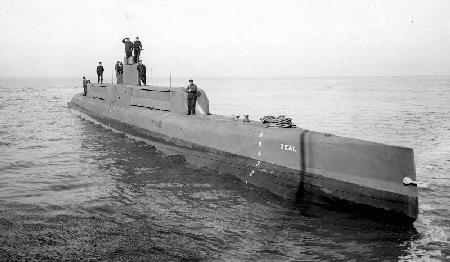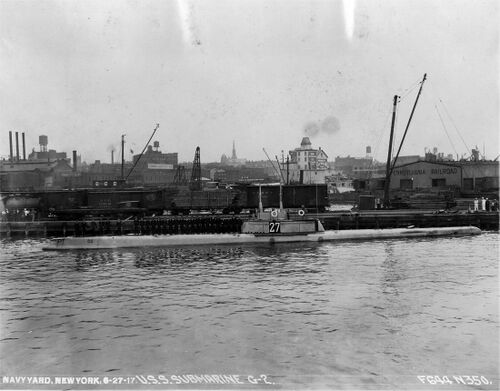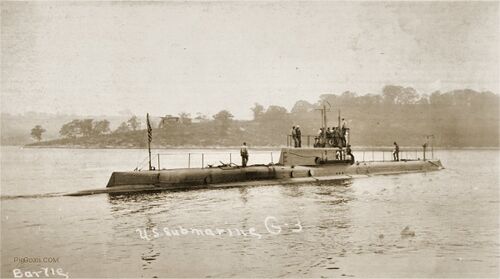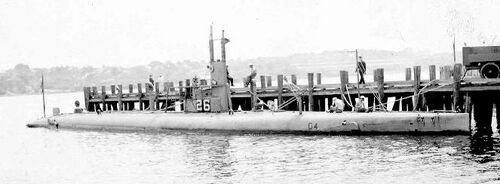G-class: Difference between revisions
Pbc captain (talk | contribs) |
Pbcjohnston (talk | contribs) mNo edit summary |
||
| (53 intermediate revisions by 3 users not shown) | |||
| Line 1: | Line 1: | ||
[[File:G-Boat Header 2.jpg|center]] | |||
[[File: | |||
===<big>Design, Construction, and Naming Notes</big>=== | |||
<div style="text-align: justify;"><span style="color:#00008B">The four G-class harbor defense submarines were not actually a class at all. They were built to four completely different designs, but they were intended to have similar military characteristics, so they were grouped together. They were named Seal, Tuna, Turbot, and Thrasher when ordered, but their names were all changed to the G-class names on November 17, 1911, well before any of them had been commissioned. G-1 and G-2 were of a related Lake Torpedo Boat Co. design and were built by the Newport News Shipbuilding & Drydock Co. in Newport News, VA. G-3 was of a modified Lake design whose construction was started at the Lake company yard in Bridgeport, Connecticut. Lake ran into severe financial difficulties and declared bankruptcy, so G-3 had to be towed to the New York Navy Yard for completion. G-4 was an ill-advised attempt to introduce competition to the submarine acquisition process, being built to an Italian Laurenti design at William Cramp & Sons Shipbuilding Co. in Philadelphia. Due to the haphazard process that the Navy used to award the contracts, the hull numbers assigned to these boats fell out of sequence. None of these boats were considered successful, spending an average of just six years in service before being decommissioned and disposed of. | |||
G-1 represents a unique anomaly in the USN. Her development and construction was so troubled that the Navy was very unsure if they would even accept it. When it did eventually pass acceptance trials, the Navy awkwardly assigned it hull number 19½, the only time in its entire history that the Navy assigned half a hull number to a commissioned warship. When the [[F-1|'''USS F-1 (Submarine No. 20)''']] was lost in a collision, the Navy took another unprecedented step and reassigned the F-1's hull number to G-1. She was eventually redesignated in the SS series, but not long after she was disposed of as a depth charge target.</span> | |||
[[File:Red bar sub.jpg]] | |||
</div> | |||
===<big>Seal/G-1 (Submarine No. 19½, later SS-20)</big>=== | |||
[[File:Seal 1.jpg|left|500px|Submarine Seal, February 8, 1911.]] | |||
<div style="text-align: justify;"><span style="color:#00008B">Simon Lake's submarine Seal is shown here shortly after her launch from Newport News Shipbuilding, Virginia on February 8, 1911. It would be nearly another two years before she was commissioned into the United States Navy, and then only reluctantly. During this fitting out period her name was changed to G-1. | |||
The large superstructure amidships covers a set of torpedo tubes that were designed to swing out so that they could be fired to either side. These tubes proved to be a failure because the weapons stored in them could not be serviced by the crew, and because of the inability to accurately aim the tubes. They were later removed.</span> | |||
[[G-1|See more G-1 photos]] | |||
[[File:Red bar sub.jpg]] | |||
File: | |||
</ | </div> | ||
== | ===<big>Tuna/G-2 (Submarine No. 27)</big>=== | ||
[[File:G2-g2bny1-01.jpg|left|500px|Photo courtesy of the National Archives]] | |||
<div style="text-align: justify;"><span style="color:#00008B">The G-2 shown alongside at the Brooklyn Navy Yard, June 27, 1917. Her crew is lined up topside for a photo opportunity. G-2 was a sleek and handsome boat, contradicting the fact that she was operationally unreliable and largely considered a failure. Her sharply raked back superstructure at the bow hid a single torpedo tube. The circular plates amidships were floodports for Simon Lake's trademark watertight superstructure, intended to provide extra buoyancy while surfaced. At this early stage of her short career, G-2 does not yet have a bridge structure installed, one would be added later. Her twin, widely spaced periscopes are fixed in height and do not retract. The superstructure aft also conceals a torpedo tube.</span></div> | |||
[[G- | [[G-2|See more G-2 photos]] | ||
== | [[File:Red bar sub.jpg]] | ||
[[File: | |||
===<big>Turbot/G-3 (Submarine No. 31)</big>=== | |||
[[File:G3-g3wcrew-03.jpg|left|500px|Photo in the private collection of Ric Hedman.]] | |||
<div style="text-align: justify;"><span style="color:#00008B">The G-3 at an unknown location but possibly on the Thames River, Connecticut, summer 1916. The submarine is proceeding at a very slow pace on the battery with her engines shut down. The battery was used on these early subs when maneuvering near a pier. The direct drive diesels were incapable of being reversed, so if a backing bell was needed the electric motors had to be used. On the far left at the tip of the superstructure are two doors that open to port and starboard, revealing two aft firing 18" torpedo tubes. These were single shot tubes and could only be reloaded in-port. | |||
Many of the crew are on the top of the large conning tower fairwater and on deck. The weather seems to be warm since shirt sleeves and light jackets seem to be the norm. Seen in the left background is a large building on top of the hill. It is possibly the Coast Guard Academy or Connecticut College. The photo is taken pre-WWI before the steel chariot bridges were adopted by the US Navy, so the date is probably the summer of 1915.</span> | |||
[[G-3|See more G-3 photos]] | |||
[[File:Red bar sub.jpg]] | |||
</div> | |||
===<big>Thrasher/G-4 (Submarine No. 26, later SS-26)</big>=== | |||
[[File:G4-4g44-16.jpg|left|500px|U.S. Navy photo]] | |||
<div style="text-align: justify;"><span style="color:#00008B">G-4 moored at Submarine Base New London, CT., 1915-16. This photo shows her with a modification to her periscope shears, with bracing and metal plating added in an attempt to keep them from vibrating while running submerged. The Laurenti design awkwardly placed these fixed height periscopes forward of the conning tower. On the far left, the boat's topside rudder can be seen.</span></div> | |||
[[G-4|See more G-4 photos]] | |||
[[File:Subs bottom line 2.jpg]] | |||
<center>[[Submarine Classes|Return to the Submarine Classes page]]</center> | |||
[[File:Red bar sub new.jpg]] | |||
<center> | |||
Page created by:<br> | |||
<span style="color:#00008B"> | |||
<small>Ric Hedman & David Johnston<br> | |||
1999 - 2023 - PigBoats.COM<sup>©</sup><br> | |||
Mountlake Terrace, WA, Norfolk, VA<br> | |||
webmaster at pigboats dot com</small> | |||
</center> | |||
[[File:Subs bottom line 2.jpg]] | |||
Latest revision as of 00:36, 6 September 2024

Design, Construction, and Naming Notes
G-1 represents a unique anomaly in the USN. Her development and construction was so troubled that the Navy was very unsure if they would even accept it. When it did eventually pass acceptance trials, the Navy awkwardly assigned it hull number 19½, the only time in its entire history that the Navy assigned half a hull number to a commissioned warship. When the USS F-1 (Submarine No. 20) was lost in a collision, the Navy took another unprecedented step and reassigned the F-1's hull number to G-1. She was eventually redesignated in the SS series, but not long after she was disposed of as a depth charge target.
Seal/G-1 (Submarine No. 19½, later SS-20)

The large superstructure amidships covers a set of torpedo tubes that were designed to swing out so that they could be fired to either side. These tubes proved to be a failure because the weapons stored in them could not be serviced by the crew, and because of the inability to accurately aim the tubes. They were later removed.
Tuna/G-2 (Submarine No. 27)

Turbot/G-3 (Submarine No. 31)

Many of the crew are on the top of the large conning tower fairwater and on deck. The weather seems to be warm since shirt sleeves and light jackets seem to be the norm. Seen in the left background is a large building on top of the hill. It is possibly the Coast Guard Academy or Connecticut College. The photo is taken pre-WWI before the steel chariot bridges were adopted by the US Navy, so the date is probably the summer of 1915.
Thrasher/G-4 (Submarine No. 26, later SS-26)

Page created by:
Ric Hedman & David Johnston
1999 - 2023 - PigBoats.COM©
Mountlake Terrace, WA, Norfolk, VA
webmaster at pigboats dot com